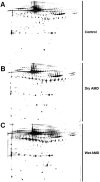Comparative proteomic analysis of plasma proteins in patients with age-related macular degeneration
- PMID: 24790867
- PMCID: PMC4003079
- DOI: 10.3980/j.issn.2222-3959.2014.02.12
Comparative proteomic analysis of plasma proteins in patients with age-related macular degeneration
Abstract
Aim: To find the significant altered proteins in age-related macular degeneration (AMD) patients as potential biomarkers of AMD.
Methods: A comparative analysis of the protein pattern of AMD patients versus healthy controls was performed by means of proteomic analysis using two-dimensional gel electrophoresis followed by protein identification with MALDI TOF/TOF mass spectrometry.
Results: We identified 28 proteins that were significantly altered with clinical relevance in AMD patients. These proteins were involved in a wide range of biological functions including immune responses, growth cytokines, cell fate determination, wound healing, metabolism, and anti-oxidance.
Conclusion: These results demonstrate the capacity of proteomic analysis of AMD patient plasma. In addition to the utility of this approach for biomarker discovery, identification of alterations in endogenous proteins in the plasma of AMD patient could improve our understanding of the disease pathogenesis.
Keywords: age-related macular degeneration; clinical patients; comparative proteomics; plasma proteins; two-dimensional electrophoresis.
Figures




Similar articles
-
Tear film proteome in age-related macular degeneration.Graefes Arch Clin Exp Ophthalmol. 2018 Jun;256(6):1127-1139. doi: 10.1007/s00417-018-3984-y. Epub 2018 Apr 25. Graefes Arch Clin Exp Ophthalmol. 2018. PMID: 29696386 Free PMC article.
-
Systematic Review of Proteomics in Age-Related Macular Degeneration and Pathway Analysis of Significant Protein Changes.Ophthalmol Sci. 2025 Apr 11;5(5):100793. doi: 10.1016/j.xops.2025.100793. eCollection 2025 Sep-Oct. Ophthalmol Sci. 2025. PMID: 40496216 Free PMC article. Review.
-
Proteomic analysis of the aqueous humor in patients with wet age-related macular degeneration.Proteomics Clin Appl. 2013 Aug;7(7-8):550-60. doi: 10.1002/prca.201200012. Epub 2013 May 7. Proteomics Clin Appl. 2013. PMID: 23418058
-
Identification of vinculin as a potential plasma marker for age-related macular degeneration.Invest Ophthalmol Vis Sci. 2014 Oct 8;55(11):7166-76. doi: 10.1167/iovs.14-15168. Invest Ophthalmol Vis Sci. 2014. PMID: 25298412
-
Systemic and ocular fluid compounds as potential biomarkers in age-related macular degeneration.Surv Ophthalmol. 2018 Jan-Feb;63(1):9-39. doi: 10.1016/j.survophthal.2017.05.003. Epub 2017 May 15. Surv Ophthalmol. 2018. PMID: 28522341 Review.
Cited by
-
Tear film proteome in age-related macular degeneration.Graefes Arch Clin Exp Ophthalmol. 2018 Jun;256(6):1127-1139. doi: 10.1007/s00417-018-3984-y. Epub 2018 Apr 25. Graefes Arch Clin Exp Ophthalmol. 2018. PMID: 29696386 Free PMC article.
-
Systematic Review of Proteomics in Age-Related Macular Degeneration and Pathway Analysis of Significant Protein Changes.Ophthalmol Sci. 2025 Apr 11;5(5):100793. doi: 10.1016/j.xops.2025.100793. eCollection 2025 Sep-Oct. Ophthalmol Sci. 2025. PMID: 40496216 Free PMC article. Review.
-
Proteomics-based approach for differentiation of age-related macular degeneration sub-types.Indian J Ophthalmol. 2021 Mar;69(3):647-654. doi: 10.4103/ijo.IJO_470_20. Indian J Ophthalmol. 2021. PMID: 33595494 Free PMC article.
References
-
- Rudnicka AR, Jarrar Z, Wormald R, Cook DG, Fletcher A, Owen CG. Age and gender variations in age-related macular degeneration prevalence in populations of European ancestry: a meta-analysis. Ophthalmology. 2012;119(3):571–580. - PubMed
-
- Lim LS, Mitchell P, Seddon JM, Holz FG, Wong TY. Age-related macular degeneration. Lancet. 2012;379(9827):1728–1738. - PubMed
-
- Liang FQ, Godley BF. Oxidative stress-induced mitochondrial DNA damage in human retinal pigment epithelial cells: a possible mechanism for RPE aging and age-related macular degeneration. Exp Eye Res. 2003;76(4):397–403. - PubMed
-
- Howes KA, Liu Y, Dunaief JL, Milam A, Frederick JM, Marks A, Baehr W. Receptor for advanced glycation end products and age-related macular degeneration. Invest Ophthalmol Vis Sci. 2004;45(10):3713–3720. - PubMed
LinkOut - more resources
Full Text Sources
